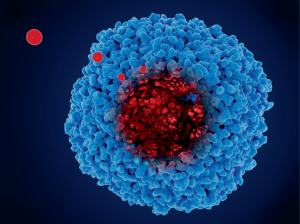Polyethylene glycol (PEG) is a commonly used coating agent in nanomedicine, but there are growing concerns about its immunogenicity. Two Comment articles discuss the issue and possible alternatives to PEG.
A challenge for successful translation of nanomedicines is engineering their biological identity. Upon injection in the body, nanoparticles are quickly coated by layers of endogenous proteins — the protein corona — that eventually determine their likelihood of evading clearance by the mononuclear phagocytic system (the body’s first line of defence) as well as their targeting capability and cellular uptake.

Credit: Juan Gaertner / Science Photo Library / Getty Images
A common strategy to modulate protein corona formation is coating the nanoparticles with PEG — an antifouling polymer that imparts stealth properties to and extends circulation lifetime of nanomedicine.
However, while PEG’s established low toxicity in humans, widespread use in drugs approved by the US Food and Drug Administration and favourable physicochemical properties have made it the polymer of choice for nanomedicine surface modification, it presents some drawbacks, particularly its effect on targeting capabilities and its potential immunogenicity1.
Two Comment articles published in the current issue of Nature Nanotechnology explore the use of this polymer in nanomedicine and the ongoing debate around possible substitutes.
In their Comment, Ju and Kent examine the balance between PEG-induced stealth properties and targeting efficiency. PEG coating reduces nonspecific protein binding and accelerated blood clearance, enhancing the stability of nanoparticles in the bloodstream. At the same time, functionalizing PEGylated nanoparticles with antibodies increases targeting efficiently, but it can compromise stealth. An optimal balance may be achieved by fine-tuning the PEG:antibody ratio, PEG chain length and molecular weight, ligand orientation, and ligand size. Alternatively, engineering an ad hoc artificial protein corona or a better understanding of naturally formed ones could drive organ-specific targeting.
Ju and Kent also address the issue of PEG immunogenicity. Anti-PEG antibodies were first identified in animals exposed to PEGylated proteins in the 1980s2. Subsequent studies linked these antibodies to decreased stealth and diminished efficacy of PEGylated nanomedicine3,4. These challenges have been known since the early 2000s, but the issue became more pressing during the COVID-19 pandemic, due to hypersensitivity reactions observed with the use of PEGylated lipid nanoparticles as vaccines. It is likely, however, that polymeric alternatives would also elicit an immune response over time, presenting similar issues to PEG. One clinical solution could be to alternate between different stealth polymers to minimize antibody development against any single one.
In a second Comment, Dobrovolskaia also discusses the issue of potential immunogenicity of the PEG alternatives and raises additional points. There are two major gaps in knowledge that need to be addressed before considering alternatives. One is the lack of a standardized methodology, control, and reagents for the detection of binding antibodies. The term ‘immunogenicity’ is often misused in the literature to refer to cytokine production, which, while easier to measure, does not necessarily correlate with antigen-specific cellular or humoral response. There is therefore the need to clearly evaluate whether a product is immunogenic (that is, generates antibodies) or immunostimulant (that is, leads to cytokine release without antibody production). The second gap is the need for a deeper understanding of the mechanisms leading to PEG immunogenicity. This includes analysing the nature of the generated antibodies, as not all antibodies are functionally equivalent, with different subclasses and isotypes displaying various degrees of immunotoxicity. Additionally, whether PEG is free, or conjugated to a protein or to a nanoparticle can affect antibody generation.
Dobrovolskaia also points to existing regulatory frameworks governing anti-drug antibody response to biologics (including PEGylated proteins), which comprise several optimized models and strategies. Although these frameworks are designed for small drugs, the nanomedicine community too should refer to them and adopt similar approaches to understand and manage PEG-related immunotoxicity. Each PEGylated product and each nanomedicine with a different surface coating should be analysed as a unique case, considering both antibody-dependent and antibody-independent toxicity in its specific molecular and clinical context.
An increased awareness of the tools available to assess immunotoxicity and a deeper understanding of the mechanisms underpinning polymers’ immunogenicity will allow for more accurate risk assessment and will support the design of tailored safety strategies intended to optimize the benefit to risk ratio of PEG and other coating agents.
